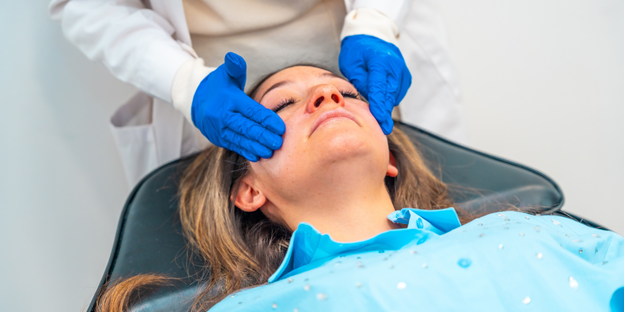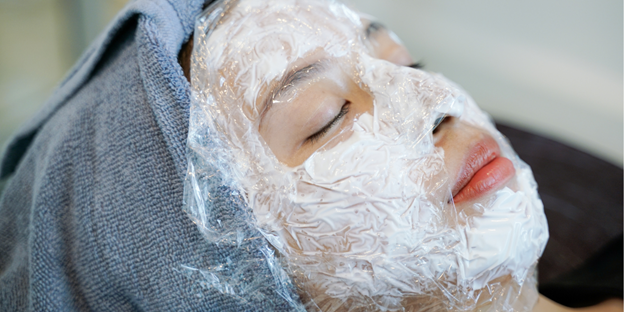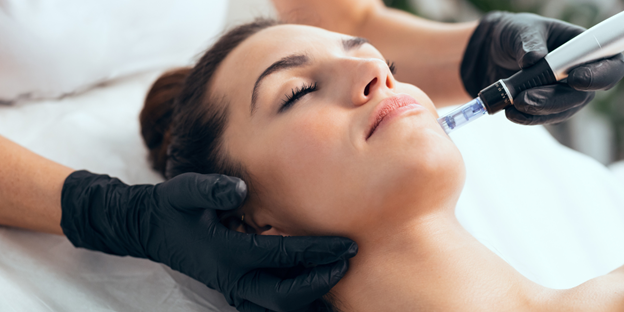
Microneedling, a popular cosmetic procedure, involves using tiny needles to create micro-injuries on the skin. This process stimulates the body’s natural healing response, promoting collagen and elastin production, which results in smoother, firmer, and more youthful-looking skin.
However, the procedure can be uncomfortable or even painful for some patients. To mitigate discomfort, practitioners often use topical numbing creams. This article will discuss choosing the best topical numbing creams for microneedling procedures, considering effectiveness, safety, and patient comfort.
Understanding Microneedling And The Need For Numbing Creams
Microneedling has gained popularity due to its efficacy in treating various skin concerns, including fine lines, wrinkles, acne scars, and hyperpigmentation. The procedure’s success largely depends on patient compliance and comfort. Since microneedling can be painful, especially on sensitive areas like the face, numbing creams are essential to enhance the patient experience and ensure they complete the treatment.
How Topical Numbing Creams Work
Topical numbing creams, also known as local anesthetics, temporarily block nerve signals in the skin. They typically contain active ingredients like lidocaine, prilocaine, benzocaine, or tetracaine. These ingredients penetrate the skin and inhibit the sodium channels in nerve cells, preventing the transmission of pain signals to the brain.
Key Factors To Consider When Choosing A Numbing Cream
When selecting a numbing cream for microneedling, it’s crucial to consider several factors to ensure optimal patient comfort and safety.
1. Active Ingredients
The most common active ingredients in numbing creams are lidocaine, prilocaine, benzocaine, and tetracaine. Each has its unique properties:
- Lidocaine: Lidocaine is widely used for its effectiveness and quick onset of action. It typically starts working within 20-30 minutes and can last up to two hours.
- Prilocaine: Often combined with lidocaine for enhanced efficacy. It has a slower onset but can provide longer-lasting numbness.
- Benzocaine: Known for its rapid onset of action but shorter duration. It’s suitable for shorter procedures.
- Tetracaine: Provides deep numbing and is often used for more extensive procedures. It has a slower onset but can last several hours.
2. Concentration of Active Ingredients
The concentration of the active ingredient is crucial in determining the cream’s effectiveness. Higher concentrations generally provide more profound and longer-lasting numbing. However, they may also increase the risk of side effects. For microneedling, a lidocaine concentration of 4-5% is commonly used. Higher concentrations should be used with caution and under professional supervision.
3. Onset and Duration of Action
The onset and duration of action are essential factors to consider. A cream with a quick onset allows for shorter preparation times, while a more prolonged duration ensures the patient remains comfortable throughout the procedure. For microneedling, creams with an onset of 20-30 minutes and a duration of 1-2 hours are ideal.
4. Skin Penetration
Effective numbing creams must penetrate the skin’s outer layer to reach the nerves. Factors such as the cream’s formulation, the presence of penetration enhancers, and the skin’s condition can affect penetration. Creams with ingredients like propylene glycol and ethoxydiglycol are known to enhance skin penetration.
5. Safety and Side Effects
Patient safety is paramount when choosing a numbing cream. Potential side effects include allergic reactions, skin irritation, and systemic toxicity, especially with high concentrations of active ingredients. It’s essential to perform a patch test before applying the cream to a larger area and to follow the manufacturer’s instructions carefully.

Top Recommended Numbing Creams for Microneedling
Here are some of the best topical numbing creams used for microneedling procedures based on their effectiveness, safety, and patient satisfaction.
1. Curist – Lidocaine Numbing 5% (OTC) Numbing Cream
Curist Lidocaine Numbing Cream contains 5% lidocaine, making it a powerful over-the-counter option for pain relief. It has a fast onset of action, typically within 20-30 minutes, and provides effective numbing for up to one hour. Curist is known for its deep penetration and minimal side effects, making it suitable for microneedling procedures.
2. NumbSkin 10.56% Lidocaine Numbing Cream
NumbSkin offers one of the highest concentrations of lidocaine available at 10.56%. This cream provides rapid and long-lasting numbing, with an onset time of 15-20 minutes and numbness lasting up to two hours. Due to its high potency, using NumbSkin under professional guidance is crucial to avoid potential side effects.
3. BLT 123 Analgesic Numbing Cream
BLT 123 Analgesic Numbing Cream combines benzocaine, lidocaine, and tetracaine in a balanced formula. This combination provides a quick onset of action, typically within 20 minutes, and prolonged numbing for up to two hours. BLT 123 is especially effective for more extensive microneedling sessions due to its comprehensive numbing effect.
4. LMX 4 and LMX 5 (4% and 5% Lidocaine)
LMX creams are popular choices for microneedling due to their fast onset of action and high efficacy. LMX 4 contains 4% lidocaine, while LMX 5 contains 5% lidocaine. These creams typically start working within 20-30 minutes and provide numbing for up to one hour. They are known for their minimal side effects and good skin penetration.
5. EMLA Cream (2.5% Lidocaine and 2.5% Prilocaine)
EMLA cream combines lidocaine and prilocaine, providing a balanced numbing effect. It has a slower onset (about 60 minutes) but offers prolonged numbness for up to two hours. EMLA is highly effective for more extensive microneedling sessions and is well-tolerated by most patients.
3. Numb Master (5% Lidocaine)
Numb Master is a 5% lidocaine cream known for its rapid onset of action (20-25 minutes) and prolonged numbing effect (up to one hour). Its blend of skin-friendly ingredients enhances penetration and minimizes irritation, making it a popular choice among practitioners.
4. Hush Anesthetic Gel (4% Lidocaine)
Hush Anesthetic Gel is specifically formulated for cosmetic procedures, including microneedling. It contains 4% lidocaine and a combination of natural botanicals that soothe the skin. Hush Gel has a quick onset (about 20 minutes) and provides effective numbing for up to two hours.
5. Dr. Numb (5% Lidocaine)
Dr. Numb is a widely used numbing cream with 5% lidocaine. It has a fast onset (15-20 minutes) and provides numbness for up to two hours. Dr. Numb is known for its high efficacy and minimal side effects, making it suitable for various cosmetic procedures.
Application Tips for Optimal Results
Proper application is crucial to achieve the best results with topical numbing creams. Here are some tips for practitioners:
1. Clean the Skin
Before applying the numbing cream, ensure the clean and dry treatment area. Remove any makeup, dirt, or oils interfering with the cream’s absorption.
2. Apply a Thick Layer
Apply a generous, even layer of the numbing cream to the treatment area. Avoid rubbing it in, as this can reduce its effectiveness. Instead, spread it gently and evenly.
3. Cover with Occlusive Dressing
Cover the treated area with an occlusive dressing, such as plastic wrap, to enhance absorption and prevent the cream from drying out. This helps to trap the cream against the skin and improve its penetration.
4. Wait for the Recommended Time
Allow the cream to sit for the recommended time, usually 20-60 minutes, depending on the product. Ensure the patient remains comfortable and relaxed during this period.
5. Remove Excess Cream
Before starting the microneedling procedure, remove excess cream with a clean, damp cloth or gauze. Ensure the skin is dry before proceeding.
6. Monitor the Patient
During the procedure, monitor the patient for any discomfort or adverse reactions. Be prepared to adjust the treatment if necessary.

Ensuring Patient Safety And Comfort
Patient safety and comfort should always be the top priorities. Here are some additional considerations to ensure a positive experience:
1. Perform a Patch Test
Before applying the numbing cream to a larger area, perform a patch test on a small section of skin. This helps to identify any potential allergic reactions or sensitivities.
2. Follow Manufacturer’s Instructions
Always follow the manufacturer’s instructions for application and dosage. Avoid excessive cream use, which can increase the risk of side effects.
3. Educate Patients
Educate patients about the numbing process, what to expect during the procedure, and any potential side effects. Clear communication can help alleviate anxiety and ensure a smoother experience.
4. Be Prepared for Adverse Reactions
While rare, adverse reactions can occur. Be prepared to address any issues promptly and have emergency contact information readily available.
Achieving Optimal Comfort With The Right Numbing Cream
Choosing the best topical numbing cream for microneedling procedures is essential for ensuring patient comfort and satisfaction. By considering factors such as active ingredients, concentration, onset and duration of action, skin penetration, and safety, practitioners can make informed decisions that enhance the overall treatment experience.
At Medical Purchasing Resource, LLC, we offer high-quality numbing creams suitable for various cosmetic procedures.
Ready to provide your patients with the ultimate comfort during microneedling procedures? Explore our top-quality numbing creams at Medical Purchasing Resource, LLC, and take your practice to the next level. For more information and to place an order, contact us today.

